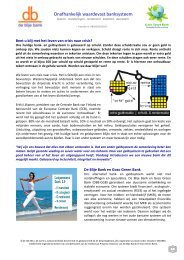De verborgen gevaren van vaccinaties - WantToKnow.nl
De verborgen gevaren van vaccinaties - WantToKnow.nl
De verborgen gevaren van vaccinaties - WantToKnow.nl
Create successful ePaper yourself
Turn your PDF publications into a flip-book with our unique Google optimized e-Paper software.
The Risks and Benefits of HPV Vaccination<br />
Charlotte Haug, MD, PhD, MSc<br />
JAMA. 2009;302(7):795-796.<br />
When do physicians know enough about the beneficial effects of a new medical<br />
intervention to start recommending or using it? When is the available information about<br />
harmful adverse effects sufficient to conclude that the risks outweigh the potential<br />
benefits? If in doubt, should physicians err on the side of caution or on the side of hope?<br />
These questions are at the core of all medical decision making. It is a complicated<br />
process because medical knowledge is typically incomplete and ambiguous. It is<br />
especially complex to make decisions about whether to use drugs that may prevent<br />
disease in the future, particularly when these drugs are given to otherwise healthy<br />
individuals. Vaccines are examples of such drugs, and the human papillomavirus (HPV)<br />
vaccine is a case in point.<br />
zur Hausen, winner of the Nobel Prize in Physiology or Medicine in 2008, discovered that<br />
oncogenic HPV causes cervical cancer. 1-4 His discovery led to characterization of the<br />
natural history of HPV infection, an understanding of mechanisms of HPV-induced<br />
carcinogenesis, and eventually to the development of prophylactic vaccines against HPV<br />
infection.<br />
The theory behind the vaccine is sound: If HPV infection can be prevented, cancer will not<br />
occur. But in practice the issue is more complex. First, there are more than 100 different<br />
types of HPV and at least 15 of them are oncogenic. The current vaccines target o<strong>nl</strong>y 2<br />
oncogenic strains: HPV-16 and HPV-18. Second, the relationship between infection at a<br />
young age and development of cancer 20 to 40 years later is not known. HPV is the most<br />
prevalent sexually transmitted infection, with an estimated 79% infection rate over a<br />
lifetime 5-6 The virus does not appear to be very harmful because almost all HPV infections<br />
are cleared by the immune system. 7-8 In a few women, infection persists and some<br />
women may develop precancerous cervical lesions and eventually cervical cancer. It is<br />
currently impossible to predict in which women this will occur and why. Likewise, it is<br />
impossible to predict exactly what effect vaccination of young girls and women will have<br />
on the incidence of cervical cancer 20 to 40 years from now. The true effect of the<br />
vaccine can be determined o<strong>nl</strong>y through clinical trials and long-term follow-up.<br />
The first HPV vaccine was licensed for use in the United States in June 2006, 9 and the<br />
Advisory Committee on Immunization Practices recommended routine vaccination of girls<br />
aged 11 to 12 years later that same month. 10 However, the first phase 3 trials of the HPV<br />
vaccine with clinically rele<strong>van</strong>t end points—cervical intraepithelial neoplasias grades 2 and<br />
3 (CIN 2/3)—were not reported until May 2007. 11 Previously o<strong>nl</strong>y reduction in the<br />
prevalence of persistent infection and CIN from the 2 virus strains included in the vaccine<br />
had been reported. The results were promising, but serious questions regarding the<br />
overall effectiveness of the vaccine for protection against cervical cancer remained to be<br />
answered, and more long-term studies were called for. 12 However, no longer-term results<br />
from such studies have been published since then.<br />
So how should a parent, physician, politician, or anyone else decide whether it is a good<br />
thing to give young girls a vaccine that partly prevents infection caused by a sexually<br />
transmitted disease (HPV infection), an infection that in a few cases will cause cancer 20<br />
to 40 years from now? Two articles in this issue of JAMA 13-14 present important data that<br />
may influence, and probably already have influenced, such decisions about HPV<br />
vaccination.<br />
136







